 Radon
Radon
What is Radon?
Radon is a naturally occurring radioactive gas that is colorless, odorless, and tasteless. It is a decay product of uranium. Though, we do not have high concentrations of uranium in the Leech Lake area, traces are common in ordinary rock and soil throughout much of the United States. This gas can then seep into our homes through cracks in home foundations and through your water.
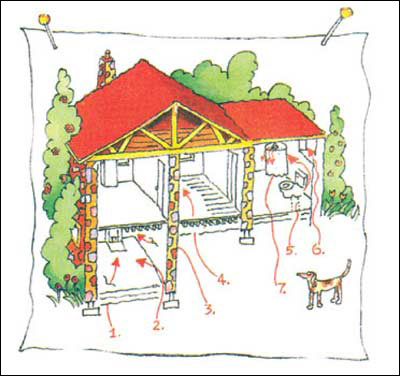
Radon get in through:
1. Cracks in solid floors
2. Construction joints
3. Cracks in walls
4. Gaps in suspended floors
5. Gaps around service pipes
6. Cavities inside walls
7. The water supply
Why Should I care, its natural?
EPA estimates that radon causes between 15,000 and 22,000 lung cancer deaths every years in the United States. Radon is the 2nd leading cause of lung cancer in the United States. Number 1 is smoking.
Any home can have a radon problem. Old, new, drafty, tight, with or without basements, crawlspaces, in all soil types, and after remodeling projects are all homes that have the potential to trap this deadly gas. One in 15 homes in the United States has radon levels above the 4 pCi/L threshold. In Minnesota 1 in 3 homes exceed this threshold.
How do you know if you have radon?
A simple test set up in the home for 3-7 days is all it takes. Results are then returned from the laboratory in two weeks.
You tested positive radon in your home. What should you do?
- Don't Panic!
- If you have performed only a single test, EPA recommends a follow up test before fixing your home. Radon levels fluctuate naturally and it is important to know if the initial test was an accurate assessment of your home's average radon level, whether the high levels could have been caused by unusual weather, or there was a false reading with the test. Also if you had a high radon reading you should also test your water, it could be contributing to the problem.
- Fixing a radon problem in your home is straight-forward and relatively low cost. Most repairs cost $1,200 but can range from $500 to $2,000. Link: Consumers Guide to Radon Reduction http://www.epa.gov/iaq/radon/pubs/consguid.html
What are other risks compound radon exposure?
Smoking combined with radon is an especially serious health risk. Stopping smoking and lowering a high radon level are the best ways to help minimize your future risk of lung cancer.
Your chances of getting lung cancer from radon depend mostly on the following factors:
• How much radon is in your home
• The amount of time you spend in your home
• Whether you are a smoker or former smoker
High radon and smoking dramatically increases your chance of lung cancer. It's never too late to reduce your risk of lung cancer. Don't wait to test and fix a radon problem. If you are a smoker, stop smoking.
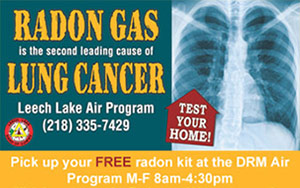 Did You Know…?
Did You Know…?
Radon is the second leading cause of lung cancer.
On average, one in 15 homes in the U.S., and one
in three homes in Minnesota have high radon levels.
FAQS
Q: I don’t need to test for radon; I have one of those detectors plugged into my wall.
A: What you are most likely referring to is Carbon Monoxide (CO) detector. These monitor the amounts of CO produced by incomplete combustion by gas furnaces, gas stoves, or other combustion sources in the home. Testing for radon does not require electricity and are for short time periods, usually one week to 3 months. Testing for radon is a passive air sample and consists of an activated charcoal packet or canister.
Q: How do you test for radon? Can I do it myself?
A. You can hire a professional to test your home, though it can be costly. On the other hand you can do a self test. You can find do-it-yourself test kits at your local hardware store or home center. However be warned that these tests have a shelf life and cost $20 to $30. We suggest ordering a test from a laboratory directly. Their price is usually less than $10. Most do-it-yourself test kits are very easy to use and get.
Q. What does a person do when they find high radon levels in their home?
A. We'll answer this by first asking: Have you retested to confirm that the radon levels are actually too high? (Do you have an average of over 4 pCi/l from the results of two or more short-term tests or from one long-term test of 90 days or more.)
More detailed information can be reviewed by clicking on the US EPA slide show .
Protecting Your Home From Radon. is a book by Doug Kladder. This book is the most complete source of information on radon mitigation techniques currently available.
If you want to hire a contractor (the cost will most likely run from $700 to $2500, according to the size of the building, etc.) then you will want to call your state radon officer and ask for a list of approved "Radon Mitigation Contractors." All of the state phone numbers are listed at the US EPA site under State Radon Contacts. If you want to locate an NEHA-certified mitigation contractor yourself, you will find a list of Residential Radon Mitigation Service Providers here.
For some official information on how to deal with a radon problem in your home check out the EPA's Consumer's Guide to Radon Reduction.
Or you may want to call the Radon Fix-it Line operated by the Consumer Federation of America (CFA) at 1-800-644-6999. They provide guidance and encouragement to consumers with elevated radon levels and will try to answer some of your most pressing questions. The Fix-it Line is only answered between noon and 8pm, Monday through Friday EST.
Q. Where can I get some information on radon in water?
A. The following is from the US EPA's Citizen's Guide to Radon:
If you've tested the air in your home and found a radon problem, and your water comes from a well, you should have your water tested for radon.
Compared with radon entering the home through soil, radon entering the home through water will in most cases be a small source of risk. Radon gas can enter the home through well water. It can be released into the air you breathe when water is used for showering and other household uses. Research suggests that swallowing water with high radon levels may pose risks, too, although risks from swallowing water containing radon are believed to be much lower than those from breathing air containing radon.
While radon in water is not a problem in homes served by most public water supplies, it has been found in well water. If you've tested the air in your home and found a radon problem, and your water comes from a well, contact a lab certified to measure radiation in water to have your water tested. Do-it-yourself radon-in-water test kit cost approximately for $19.95.
If you're on a public water supply that is pumped from wells and are concerned that radon may be entering your home through the water, call your public water supplier.
Radon problems in water can be readily fixed. The most effective treatment is to remove radon from the water before it enters the home. This is called point-of-entry treatment. Treatment at your water tap is called point-of-use treatment. Unfortunately, point-of-use treatment will not reduce most of the inhalation risk from radon.
Call your State Radon Contact or the EPA Drinking Water Hot line (800-426-4791) for more information on radon in water. Most areas of the US do NOT have a radon-in-water problem, therefore you should contact your state radon office before concerning yourself with this hazard.
Q. Are there other symptoms or health problems, other than lung cancer that are associated with radon gas exposure?
A. We receive this question from a lot of folks who have been suffering from various health problems and the basic answer is THERE ARE NO SHORT-TERM RADON EXPOSURE SYMPTOMS that have ever been documented. At least not at the levels you are likely to see in a home, school, or office. Also, YOU WILL NOT HAVE ANY OTHER bodily symptoms such as joint pain, stomach or intestinal problems, headaches, or rashes from short-term radon exposure at natural environmental levels.
It will take years of exposure at relatively high levels before you are likely to have ANY symptoms and then the only known (documented) symptoms are the same as those listed here for smoking induced Lung Cancer Symptoms.
Q. I heard the Leech Lake Air Quality Program has free kits to Leech Lake Community Members. How do I get one?
A. We did have kits available for community members. We are still available to refer you to the laboratory we used and assist with testing.
More information
Division of Resource Management, Air Quality (218) 335-7429
National Radon Information Line 1-800-SOS-RADON (1-800-767-7236)
Links for Radon
http://www.weather.com/health/invisible-killer-your-home-20140217
University of Minnesota Extension: www.extension.umn.edu/housingtech
Minnesota Department of Health: www.health.state.mn
For more detailed information on Radon please visit A Citizen’s Guide to Radon.
http://www.epa.gov/iaq/radon/pubs/citguide.html















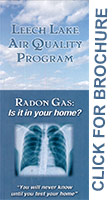
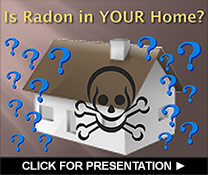
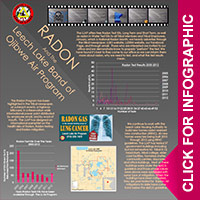
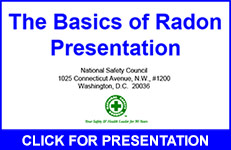
 Division of Resource Management
Division of Resource Management